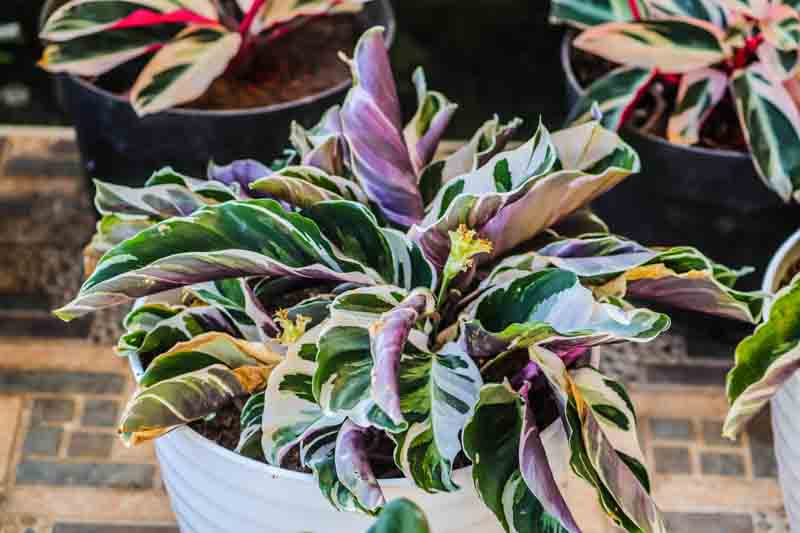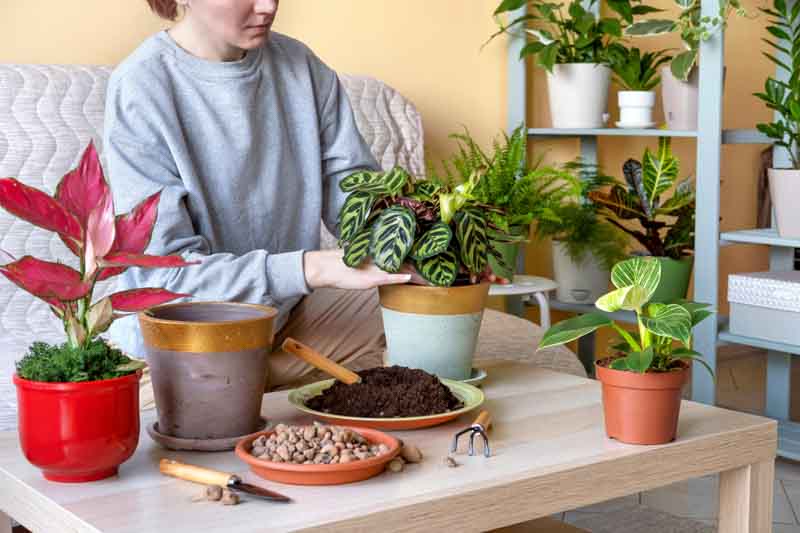Calathea 'Fusion White', Goeppertia 'White Fusion', Goeppertia 'Fusion White'
Calathea ‘White Fusion’ is a remarkably stunning and highly sought-after cultivar celebrated for its unique and vibrant foliage. This plant combines the beauty and intricate patterns with striking white, green, and lilac colors, making it a standout addition to any indoor plant collection.
Calathea ‘White Fusion’ boasts a dazzling display of variegated leaves, each one a piece of natural art. The leaves are a blend of white, green, and sometimes lilac patches, with a delicate feathering of the colors into one another. The variegation patterns are unpredictable, making each leaf and plant unique.
Native: While the ‘White Fusion’ itself is a cultivated variety and not native to any specific region, Calathea species generally originate from the tropical forests of South America, particularly in areas like Brazil and Colombia. These plants are accustomed to the warm, humid, and shaded conditions of the rainforest understory. It belongs to the arrowroot family (Marantaceae), along with the Prayer Plant.
Plant Type and Habit: White Fusion is a clump-forming evergreen perennial with leaves emerging on long, slender stalks, creating a dense and lush appearance.
Size: Typically, ‘White Fusion’ reaches about 12 to 18 inches (30 to 45 cm) in both height and spread, making it an ideal size for interior spaces that wish to add a touch of the tropics without requiring a large amount of room.
Flowers: Though Calathea ‘White Fusion’ can occasionally produce flowers, they are small, less conspicuous, and not the primary reason for its cultivation. The focus is predominantly on its stunning foliage.
Foliage: The variegated foliage is the most notable feature of ‘White Fusion,’ with each leaf displaying a unique pattern of white and green, accented by hints of lilac. The leaves also exhibit the characteristic Calathea movement, folding up at night.
Hardiness: This plant is hardy in USDA zones 11-12. It is not frost-tolerant and must be kept in environments above 60°F (15°C) to thrive.
Uses: Primarily grown for its ornamental value, Calathea ‘White Fusion’ is a popular choice for homes and offices, adding a sophisticated and vibrant touch to any setting.
Toxicity: Calathea plants are non-toxic to cats, dogs, and humans, making them a safe choice for pet owners and families. Their sap may irritate sensitive skin.
Benefits: Beyond its ornamental appeal, it improves indoor air quality by filtering out pollutants.

Caring for White Fusion Calathea Plant involves creating a balanced environment that mimics its native tropical habitat.
Light: Prefers bright, indirect sunlight. Direct sun can fade the stripes on the leaves and cause burn marks. Ideal near a window with sheer curtains or in a room that receives plenty of natural light without direct exposure.
Soil: A well-draining, peat-based mix is suitable. Mix in perlite or vermiculite to enhance drainage.
Water: Keep the soil consistently moist but not waterlogged. Overwatering can lead to root rot. Use distilled, rainwater, or filtered tap water to avoid leaf browning from fluoride and other chemicals in tap water.
Temperature and Humidity: Thrives in temperatures between 65°F (18°C) to 75°F (24°C). Avoid sudden temperature drops and cold drafts. Requires high humidity levels, ideally above 60%. Low humidity can lead to brown leaf tips and edges. Use a humidifier, place the plant on a pebble tray filled with water, or group it with other plants to increase surrounding humidity.
Fertilization: Feed with a diluted, balanced, liquid houseplant fertilizer every 4 weeks during the growing season (spring and summer). Do not fertilize in winter.
Pruning: Trim away yellow or brown leaves at the base to keep the plant looking tidy and to encourage new growth.
Cleaning: Wipe leaves with a damp cloth to remove dust and help the plant breathe.
Repotting: Every 2-3 years or when the plant becomes root-bound. Use a slightly larger pot and fresh potting mix to encourage growth.
Propagating a Calathea plant, like many other members of the Calathea genus, is best done through division. This method ensures the new plants have a good start with established roots and foliage.
Choose the Right Time: The best time for propagation is in late spring when the plant is in its active growth phase.
Prepare Your Tools and Workspace: Ensure you have clean, sharp scissors or a knife, pots for the new plants, and appropriate potting mix (peat-based or similar to what the parent plant is in). Sterilize your tools with rubbing alcohol or a bleach solution to prevent the spread of disease.
Remove the Plant from Its Pot: Carefully take your Calathea plant out of its pot. You may need to tap the pot’s sides or gently pull the plant by the base to ease it out.
Inspect and Separate the Rhizomes: Look for natural divisions in the root ball where the plant has formed distinct clumps or sections. These are your propagation points. Gently tease the roots apart with your fingers or cut through them with your clean, sharp tool if necessary. Ensure each division has a good amount of roots and at least one or two shoots (leaves).
Pot Up the Divisions: Fill your new pots with a suitable potting mix, making a hole in the center for the division. Place each division in its pot, ensuring it sits at the same depth as in the original pot. Fill around the roots with more potting mix, gently firming to support the plant.
Water and Care for Your New Plants: Water each new Calathea plant thoroughly after potting to settle the soil around the roots and eliminate air pockets. Keep the soil consistently moist but not waterlogged. Place the new plants in a warm, humid spot with indirect light, similar to the parent plant’s preferred conditions.
Monitor and Maintain Humidity: To ensure high humidity, you can cover the pots with plastic bags to create a greenhouse effect. Ensure to open the bag daily for fresh air and check the soil moisture.
Be Patient: Growth may be slow initially as your Calathea plant adjusts and develops new roots and foliage. It can take several weeks to see significant growth.

Calathea ‘White Fusion’ is relatively resistant to major problems, but like all indoor plants, it can encounter some pests, diseases, and common issues.
Spider Mites: These tiny pests can be identified by the fine webs they weave on the plant. They cause yellowing or speckled leaves. Increase humidity around the plant and wash it with a strong stream of water. For severe infestations, use insecticidal soap or neem oil.
Mealybugs: These white, cottony pests tend to cluster in leaf axils and under leaves, sucking sap and weakening the plant. Remove with alcohol-dipped cotton swabs or apply neem oil.
Aphids: Small, soft-bodied insects that can be green, black, brown, or pink, aphids typically feed in groups on the undersides of leaves. Combat them with a gentle spray of water, neem oil, or insecticidal soap to protect the plant’s health and appearance.
Scale insects: Hard or soft-bodied insects that attach themselves to the stems or leaves, causing yellowing and growth stunting. Scrape off with a fingernail or use a cotton swab dipped in rubbing alcohol. Insecticidal soap or neem oil may also be used.
Root rot: Often a result of overwatering, leading to brown, mushy roots and wilted leaves. Prevent by ensuring good drainage and letting the soil partially dry between waterings. Affected plants may need repotting with fresh soil after cutting away any rotten roots.
Leaf spot: Fungal or bacterial infections causing spots on leaves. Avoid wetting foliage when watering and improve air circulation. Remove affected leaves and treat with fungicides if necessary.
Brown Leaf Edges/Tips: Often a result of low humidity or fluoride in tap water. Use distilled water or rainwater and increase humidity around the plant.
Curling Leaves: Can indicate under-watering or too low humidity. Ensure consistent soil moisture and raise humidity levels.
Fading Leaf Color: Insufficient light can cause the vibrant patterns of your Calathea to fade. Provide bright, indirect light, but avoid direct sunlight, which can scorch the leaves.
Calathea ‘White Fusion’ is considered to be somewhat challenging to care for, mainly due to its specific requirements for humidity, light, and watering. It demands consistent moisture (without waterlogging), high humidity levels, and bright, indirect light to maintain its vibrant variegation. Sudden changes in environment or watering inconsistencies can lead to issues like browning leaf tips or loss of variegation.
Yes, Calathea ‘White Fusion’ is a tropical plant. It originates from the tropical environments of South America and thrives in conditions that mimic the warm, humid, and shaded floors of tropical rainforests. This background explains its need for high humidity and indirect sunlight, typical of tropical plants.
Calathea ‘White Fusion’ typically grows to about 1 to 2 feet (30 to 60 cm) in height and spread. Its growth can be influenced by the pot size, care provided, and environmental conditions. Proper care and optimal conditions can help it reach its full size and maintain its stunning leaf variegation.
| Hardiness |
11 - 12 |
|---|---|
| Plant Type | Houseplants, Perennials |
| Plant Family | Marantaceae |
| Genus | Goeppertia, Calathea |
| Exposure | Partial Sun |
| Season of Interest |
Spring (Early, Mid, Late) Summer (Early, Mid, Late) Fall Winter |
| Height |
1' - 2' (30cm - 60cm) |
| Spread |
1' - 2' (30cm - 60cm) |
| Maintenance | Low |
| Water Needs | Average |
| Soil Type | Loam |
| Soil pH | Acid, Neutral, Alkaline |
| Soil Drainage | Moist but Well-Drained |
| Characteristics | Showy, Evergreen |
| Garden Uses | Patio And Containers |
| Hardiness |
11 - 12 |
|---|---|
| Plant Type | Houseplants, Perennials |
| Plant Family | Marantaceae |
| Genus | Goeppertia, Calathea |
| Exposure | Partial Sun |
| Season of Interest |
Spring (Early, Mid, Late) Summer (Early, Mid, Late) Fall Winter |
| Height |
1' - 2' (30cm - 60cm) |
| Spread |
1' - 2' (30cm - 60cm) |
| Maintenance | Low |
| Water Needs | Average |
| Soil Type | Loam |
| Soil pH | Acid, Neutral, Alkaline |
| Soil Drainage | Moist but Well-Drained |
| Characteristics | Showy, Evergreen |
| Garden Uses | Patio And Containers |
How many Calathea lietzei ‘White Fusion’ do I need for my garden?
| Plant | Quantity | |
|---|---|---|
| Calathea lietzei ‘White Fusion’ | N/A | Buy Plants |
Create a membership account to save your garden designs and to view them on any device.
Becoming a contributing member of Gardenia is easy and can be done in just a few minutes. If you provide us with your name, email address and the payment of a modest $25 annual membership fee, you will become a full member, enabling you to design and save up to 25 of your garden design ideas.
Join now and start creating your dream garden!
Create a membership account to save your garden designs and to view them on any device.
Becoming a contributing member of Gardenia is easy and can be done in just a few minutes. If you provide us with your name, email address and the payment of a modest $25 annual membership fee, you will become a full member, enabling you to design and save up to 25 of your garden design ideas.
Join now and start creating your dream garden!